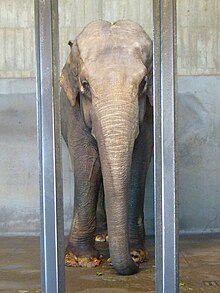Weaving (elephant)
Weaving is a behavior disorder ( stereotype ) that is widespread in captive elephants but has not yet been observed in the wild. It is characterized by a uniform pattern of movement, in which the elephant indicates steps forward and backward, while rhythmically rocking with the body and swinging the trunk or nodding the head. The term is derived from weaving , in which a weaver has to perform similarly monotonous sequences of movements.
procedure

The sequence of movements is repeated many times in identical form. While the forwards and backwards steps in young animals are often still fully carried out, they are often only indicated later by raising their feet, while animals for over 20 years usually only swing rhythmically forwards and backwards or sideways. Young elephants have a frequency of around 30 movements in one minute, older only ten.
Weaving occurs particularly often when the elephant is waiting for something (food, water, meeting with conspecifics), has been separated from conspecifics, or is denied physical contact with them (e.g. by being chained). In older animals, it may have become so deeply embedded in the behavior pattern and become independent that a reason for the behavior is no longer recognizable. Much like other stereotypes, weaving is a behavioral disorder that suggests underlying problems. It can also lead to foot and joint problems in elephants - one of the most common problems encountered in captivity.
interpretation
Scientists interpret weaving as idling movements , i.e. as an expression of an innate willingness to act , without the elephant being able to perform the species-specific locomotion and search behavior due to its captivity. It occurs almost exclusively when young animals are separated from their mother too early and taken out of their social network, so the behavior is comparable to hospitalism in humans. It can be interpreted as an expression of a stressful situation in which alternative behaviors - again due to the imprisonment - are not possible.
Eventually, the behavior solidifies to such an extent that it no longer needs a special occasion. Even if the keeping conditions of the elephant are improved (larger area, more movement, accessibility of conspecifics), it often remains on one point and is no longer able to take advantage of the larger offer.
See also
literature
- Fred Kurt (Ed.): Elephant in human hands: Research reports from Sri Lanka . Ill., Graph. Darst., Filander-Verlag, Fürth 2001, ISBN 3-930831-45-7 .
- Fred Kurt: Weaving in Asian elephants - a symptom of social isolation under chains . In: Harald M. Schwammer, Simone de Vries: Contributions to elephant keeping in Europe. Proceedings of the Elephant Carer Meeting Rotterdam, February 7th to 9th 2001 . Schüling, Münster 2002, pp. 33-49, ISBN 978-3-934849-83-9 .
- Fred Kurt, Marion E. Garai: The Asian Elephant in Captivity . Foundation Books, New Delhi 2006, ISBN 8-175963-58-1 .
Web links
- Brief overview page with photos
- Thoughts of a biologist on “species-appropriate husbandry” - Part 2: Stereotypes , a report by Dipl.-Biol. Tobias Dornbusch (PDF; 823 KB)
- The story of keeping elephants in captivity , by Fred Kurt (PDF; 1.5 MB)
